Savory Guide to Mastering Rump Steak Cooking
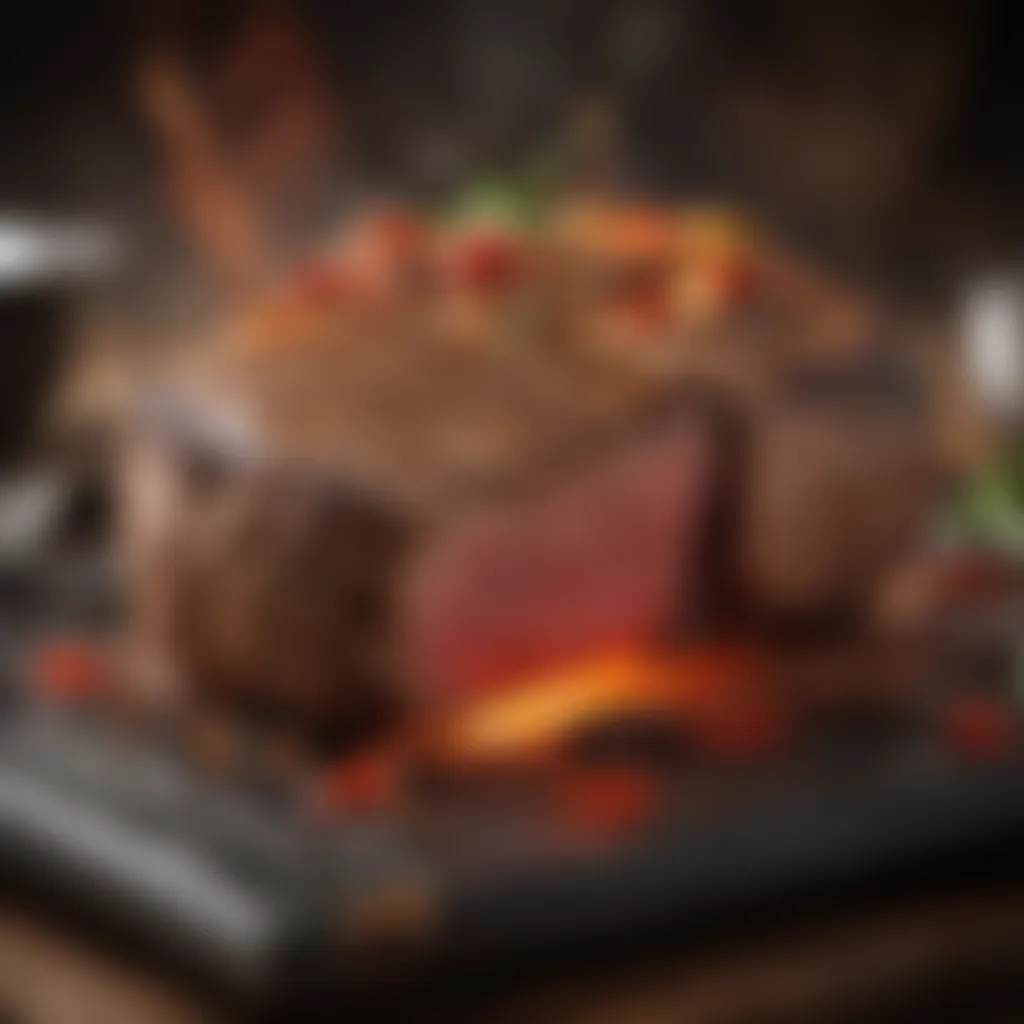
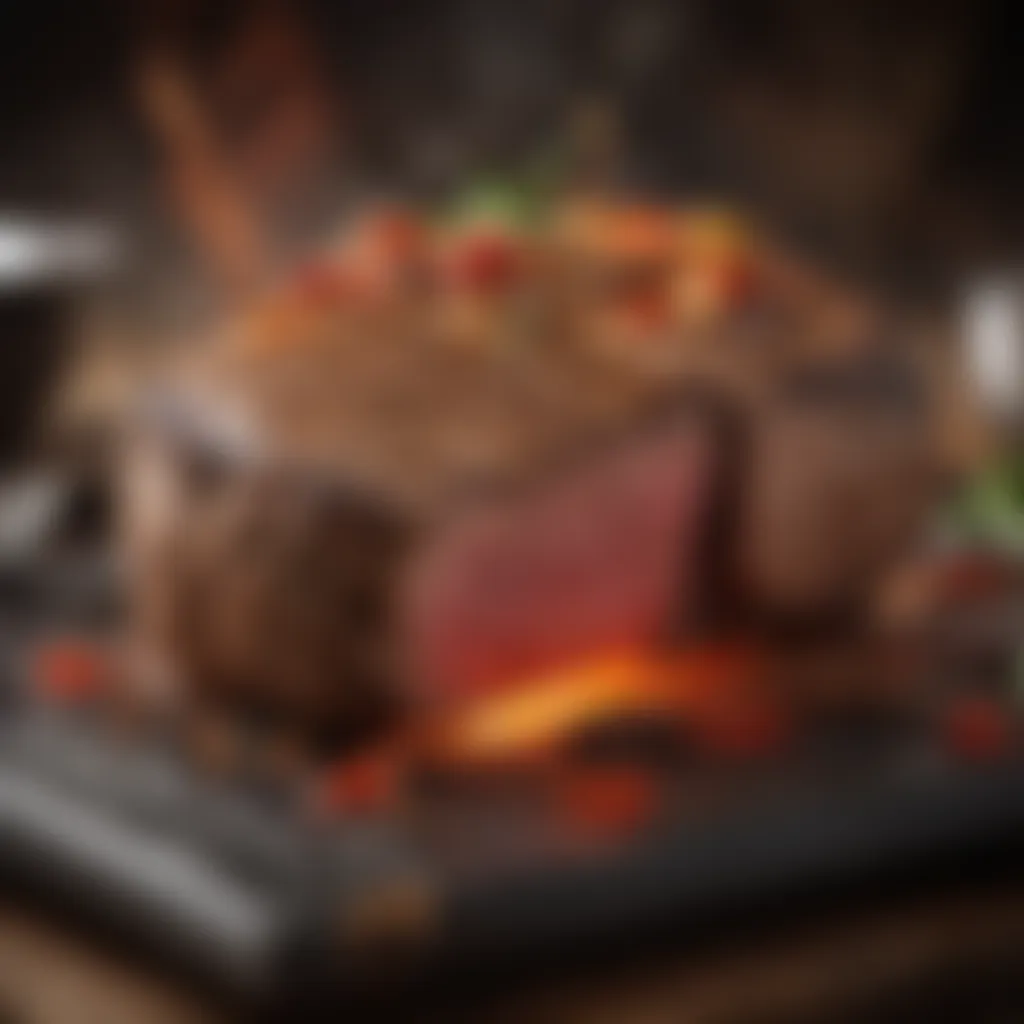
Intro
Cooking rump steak in the oven is a skill that can elevate any home kitchen experience. Whether you're trying to impress family at dinner or just wanting to enjoy a hearty meal, understanding the nuances of this specific cut can make a world of difference. Unlike pricier cuts, rump steak offers a robust flavor yet can be challenging to cook just right. But don’t worry—the pathway to oven-cooking perfection is not as daunting as it appears. In this guide, we will explore everything you need to know about cooking rump steak, from selecting your ingredients to the art of plating the final dish.
Fuel your culinary passion and get ready to turn up the oven!
Ingredients:
To achieve a mouthwatering rump steak, it is essential to gather high-quality ingredients. The following are the necessary components:
- 1 pound (450g) of rump steak
- Olive oil, 2 tablespoons
- Salt, to taste
- Black pepper, freshly ground, to taste
- Garlic powder, 1 teaspoon
- Dried thyme, 1 teaspoon
- Butter, 2 tablespoons (for basting)
- Optional garnishes: Fresh herbs (such as parsley or rosemary), lemon wedges
Detailed Instructions:
To make sure your cooking process flows without a hitch, let’s break down the steps in detail.
Preparation Steps:
- Remove Rump Steak from the Fridge: Let your steak sit at room temperature for at least 30 minutes before cooking. This step helps in achieving an even cook throughout the meat.
- Preheat the Oven: Set your oven to 425°F (220°C). This temperature is crucial for achieving a beautiful sear followed by a tender inside.
- Season the Steak: Pat the steak dry with paper towels. Drizzle olive oil over it and rub it in evenly. Then sprinkle salt, black pepper, garlic powder, and dried thyme to cover both sides.
- Choose Your Baking Dish: Use a heavy oven-safe skillet or roasting pan to ensure even heat distribution.
Technical Aspects:
- Oven Temperature: 425°F (220°C) is ideal for cooking rump steak, allowing for both searing and slow cooking.
- Timing: Depending on thickness, cook for approximately 18-25 minutes for medium-rare. For medium, aim for 25-30 minutes. Adjust your timing based on your oven’s specific heat retention.
Cooking Process:
Now comes the moment of excitement: cooking the steak!
- Sear the Steak: Heat your skillet over medium-high heat on the stove for about 5 minutes. Once hot, add a dash of olive oil and place the steak in the skillet. Sear for 2-3 minutes on each side until you see a nice brown color.
- Transfer to Oven: Once seared, transfer the skillet directly into the preheated oven. Do not cover it.
- Baste with Butter: After about 15 minutes in the oven, take out the skillet briefly, add butter on top of the steak, and baste it using a spoon. This adds flavor and moisture.
- Check the Temperature: Use a meat thermometer to check doneness—an internal temperature of 130°F (54°C) is indicative of medium-rare. Remember to let the meat rest!
Troubleshooting Tips:
- If the Steak is Overcooked: Next time, reduce your cooking time or check the temperature sooner. Keep an eye on changes past the 15-minute mark.
- Dry Steak: Consider marinating your steak prior to cooking to add moisture or decrease oven time.
Proper seasoning complements the natural flavor of the meat. A well-seasoned steak will encourage discussions around the dinner table!
In the following sections, we’ll dive deeper into mastering the finishing touches, plating, and serving this outstanding dish. Each bite should be savored, celebrating the effort you’ve put into crafting an unforgettable family meal.
Understanding Rump Steak
Understanding rump steak is key to navigating the culinary landscape of cooking this particular cut of meat. It’s a flavorful option that can be both budget-friendly and versatile in the kitchen. Knowing the intricacies of this cut makes all the difference between a decent meal and a spectacular feast.
Defining Rump Steak
Rump steak is derived from the rear section of the cow, specifically from the upper part of the hindquarters. Often considered a more economical alternative to cuts like ribeye or filet mignon, it packs a rich beefy flavor that shines when prepared correctly. The key characteristic of this cut is its balance between tenderness and robust flavor, making it ideal for various cooking methods—from roasting to braising. Using rump steak in your kitchen can elevate your meals without breaking the bank, allowing for a culinary experience that’s both satisfying and accessible.
Cuts and Grades
Choosing the right cut can significantly impact the final dish. Not only does this affect flavor, but it also determines the tenderness, which is crucial when cooking rump steak.
Selecting Quality Meat
Selecting quality meat is vital to ensuring that your rump steak not only tastes good but is also safe to eat. One of the foremost aspects to consider is the color — a deep red hue often indicates freshness. Additionally, quality meat has a slight sheen, signaling adequate handling and storage. Most importantly, sourcing from reputable suppliers guarantees a more consistent product. Choosing high-grade beef, such as USDA Prime or Choice, means you’ll benefit from both flavor and tenderness, enhancing your overall cooking experience. These higher grades often display more intramuscular fat, which results in a juicier steak when cooked.
Understanding Marbling
Marbling refers to the presence of fat interspersed within the muscle. It’s an important element in any cut of beef, and rump steak is no different. A steak with good marbling cooks up beautifully, yielding a moist and flavorful result. Higher amounts of marbling can elevate the taste dramatically, often providing that inviting rich flavor consumers seek. It’s crucial to appreciate that marbling doesn’t just contribute to flavor; it also affects the steak’s tenderness. Generally, more marbling equates to a more pleasurable eating experience, making marbling a sought-after attribute in quality meat.
Nutritional Aspects
Rump steak isn’t just a treat for your taste buds; it also brings nutritional benefits to the table, making it a valuable addition to your diet.
Protein Content
The protein content in rump steak is another significant factor—it provides a rich source of essential amino acids necessary for muscle repair and growth. A typical serving can deliver approximately 22 grams of protein per 100 grams, making it a robust choice for those seeking to boost their protein intake. Incorporating rump steak into your meals can help you meet your dietary protein needs, especially for active individuals or those trying to build muscle.
Vitamins and Minerals
Vitamins and minerals found in rump steak further enhance its appeal. This cut is a good source of vitamin B12, which is essential for nerve function and the formation of red blood cells. Additionally, it contains minerals such as iron and zinc, which play a critical role in various bodily functions, including immune support and energy production. Thus, integrating rump steak into your diet not only satisfies your taste but also supports overall health.
Preparing for Cooking
Getting ready to cook rump steak isn’t just about tossing it into the oven. It involves a series of important steps that lay the foundations for a flavorful and tender result. This part of the process allows you to manage expectations and ensures that every bite is worth savoring. Preparation helps in making sure that all the tools, ingredients, and techniques align for that cooked-to-perfection rump steak. The benefits of preparation are manifold: it minimizes the odds of mistakes, enhances flavor through correct seasoning, and creates a more enjoyable cooking experience.
Essential Tools and Equipment
Choosing the Right Oven


Selecting an oven might seem like a simple task, but it plays a huge role in how your steak turns out. Not all ovens cook the same way; some are powered by gas, while others are electric. Gas ovens tend to heat up rapidly and allow for quick temperature adjustments, giving you more control during the cooking process. In contrast, electric ovens offer more steady heat, which can be beneficial for events requiring long cooking times.
A significant aspect to consider is the size of the oven. Having ample space is advantageous, especially when you want to avoid overcrowding. This ensures consistent heat circulation around the steak. Each oven might have its quirks too, like hot spots, so taking time to understand its performance can save you from potential overcooking. For a perfect rump steak, the right oven can mean all the difference.
Utilizing Meat Thermometers
When it comes to cooking meat, precision is key. This is where meat thermometers shine. They allow you to monitor the internal temperature of the steak accurately. There are various types of thermometers: instant-read, digital, and probe-style. Instant-read thermometers give you a quick glimpse of the temperature but may need some adjustment if you’re aiming for exactness. On the other hand, digital models can provide an ongoing temperature read, allowing you to stay focused on other tasks.
Using a meat thermometer takes the guesswork out of cooking as it helps you achieve your desired level of doneness. You can be confident that your rump steak is cooked just right, eliminating the risk of serving something that is either raw or overly done.
Marinades and Seasoning
Basic Marinade Recipes
Incorporating marinades is one of the basic steps to infusing flavor into your steak. The beauty of marinades lies in their versatility; a simple mix of olive oil, vinegar or citrus juice, salt, and spices can elevate the steak’s taste significantly. They not only contribute flavor but also help tenderize the meat. The acid from the vinegar or citrus breaks down some of the tough fibers, enhancing the eating experience.
For busy cooks or those short on time, a quick marinade can be made within minutes. Just allow the meat to soak for at least thirty minutes, although longer marinating times yield the best results. Experimenting with different ingredients like soy sauce, garlic, or herbs can lead to unique flavor profiles that can please any palate.
Timing for Maximum Flavor
Timing plays a critical role in how well the flavors develop. A common misconception is that longer means better in terms of marinating. While extended times can deepen flavors, they don’t always work well for every ingredient. For instance, if you use a marinade with high acid content, allowing the meat to sit for too long might result in a mushy texture instead of the desired tenderness.
As a rule of thumb, denser cuts can handle longer marinating times, while more delicate cuts like flank steak may require just a quick soak. So, keeping an eye on the clock is essential for getting flavor just right without compromising texture.
Resting and Trimming
Resting Techniques
Resting might seem unnecessary, but it's crucial for ensuring juicy results. Allowing the steak to rest after cooking helps the juices redistribute throughout the meat rather than pooling on your plate. This technique is not just a formality; it's a step toward achieving a steak that's moist and flavorful.
When it’s removed from the oven, covering it loosely with foil maintains warmth while reducing heat loss. A good resting time can be anywhere from 5 to 15 minutes, depending on the steak’s thickness. Ultimately, incorporating this step leads to a more satisfying eating experience.
Removing Excess Fat
Trimming excess fat helps in achieving a clean taste and enhances the overall cooking process. While some fat is beneficial for flavor, an overload can lead to a greasy steak that's off-putting. Taking the time to remove tough fat from the edges allows for more even cooking and can significantly improve the texture of each bite.
In the end, balancing how much fat to leave on while ensuring the steak remains juicy is an art form. A little fat goes a long way in flavor while ensuring the meat remains enjoyable. This way, you’ll have a rump steak that not only looks appealing but is filled with flavors that have a lasting impression.
Oven Cooking Techniques
Understanding how to properly cook rump steak in the oven isn’t just about following a recipe; it’s about mastering particular techniques that can make or break your dish. Oven cooking techniques play a crucial role in delivering the flavors and tenderness you desire. Each method impacts the steak’s texture, moisture retention, and overall flavor. Here’s a closer look at the primary oven cooking methods you will encounter, along with detailed guidance on how to get the best results.
Roasting
Temperature Guidelines
When it comes to roasting, temperature is king. The general recommendation for cooking rump steak is a temperature between 375°F (190°C) and 425°F (220°C). Cooking at this range allows the outside to develop a beautiful crust while keeping the interior juicy. One key advantage of roasting at a higher temperature is the Maillard reaction, which is the chemical reaction that gives browned food its distinctive flavor. However, caution is vital – if the temperature is too high, the outside can become overly charred while the inside remains undercooked. Therefore, it’s about striking a balance and keeping an eye on your steak.
Timing for Perfectly Cooked Steak
Timing in the oven cannot be overstated. A good rule of thumb for a medium-rare rump steak is around 20 minutes per pound. This guideline can ensure the meat is not only cooked but maintains a juicy quality. However, every oven is unique – some heat up differently and certain factors like the steak’s thickness and initial temperature also play a part. A meat thermometer is an invaluable tool during this process, helping you gauge when your steak hits that precious internal temperature of 130-135°F (54-57°C) for medium-rare. In the end, timing is not just about the clock; it calls for attentiveness and a bit of instinct.
Baking
Understanding the Bake Process
Baking can seem like an undervalued technique for cooking rump steak, but it has merits that shouldn't be ignored. This method allows for a more uniform heat distribution, which can be particularly beneficial for larger cuts of meat. When you bake, you create an environment where the steak cooks gently, which can help maintain moisture. One unique aspect of baking is that it requires less monitoring than other cooking methods, allowing you to prep sides or finish up other dishes while your steak is in the oven. However, you must be careful about the time and temperature; too low of a heat can lead to a dry piece of meat.
Advantages of Baking Rump Steak
Baking offers a few significant advantages. For one, it often requires fewer ingredients and less fussing over heat. Moreover, it lends itself well to infusing flavor. You can easily place herbs and spices atop or around the steak in the baking dish, allowing them to meld into the meat as it cooks. One downside to consider is that you won’t get that same caramelized crust that other methods like roasting might achieve, so it’s a bit of a balancing act in terms of complexity versus flavor. Overall, baking is a great choice for anyone looking to simplify the cooking process while still producing tender and flavorful results.
Broiling
Broiling vs. Roasting
Broiling is often mistaken for roasting, yet the two techniques differ significantly. While roasting cooks food evenly around, broiling uses direct heat from above, creating a searing effect at much higher temperatures. This method can lead to a nice char on the steak's surface while leaving the inside tender. Broiling is particularly useful if you’re after that crusty exterior and want your steak to develop complex flavors quickly. However, because of that intense heat, vigilant attention is necessary to avoid overdoing it.
Adjusting Cooking Position
When broilng, adjusting the cooking position can be a game-changer. Generally, placing the steak closer to the heat source can enhance charring and flavor. However, this proximity also invites the risk of burning, so you must keep a watchful eye. It’s often advantageous to start the steak farther away and then move it closer as it cooks, allowing for greater control over doneness. This technique highlights the importance of not just knowing how to cook, but also how to adapt while cooking, leading to beautifully cooked ribs every time.
Achieving the Desired Doneness
Getting the doneness right is one of the most critical aspects of cooking rump steak. Not only does it affect flavor, but it shapes the overall texture and juiciness of the meat. Too often, a home cook can fall into the trap of second-guessing their instincts, leading to overcooked or underdone steak. This part of the guide focuses on aligning your cooking process with specific doneness levels, allowing for an informed, confident approach. By understanding optimal temperatures and visual cues, you can elevate your dish from average to exquisite.
Temperature Ranges
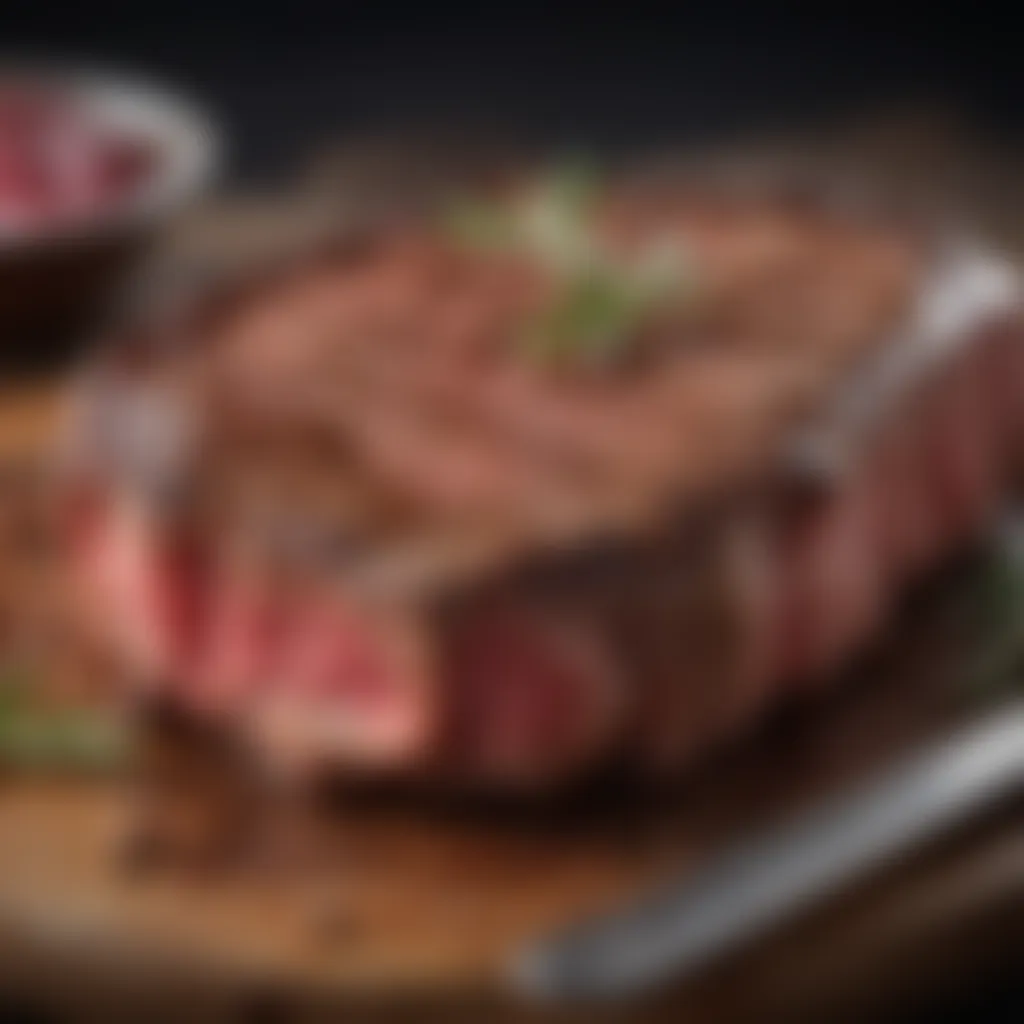
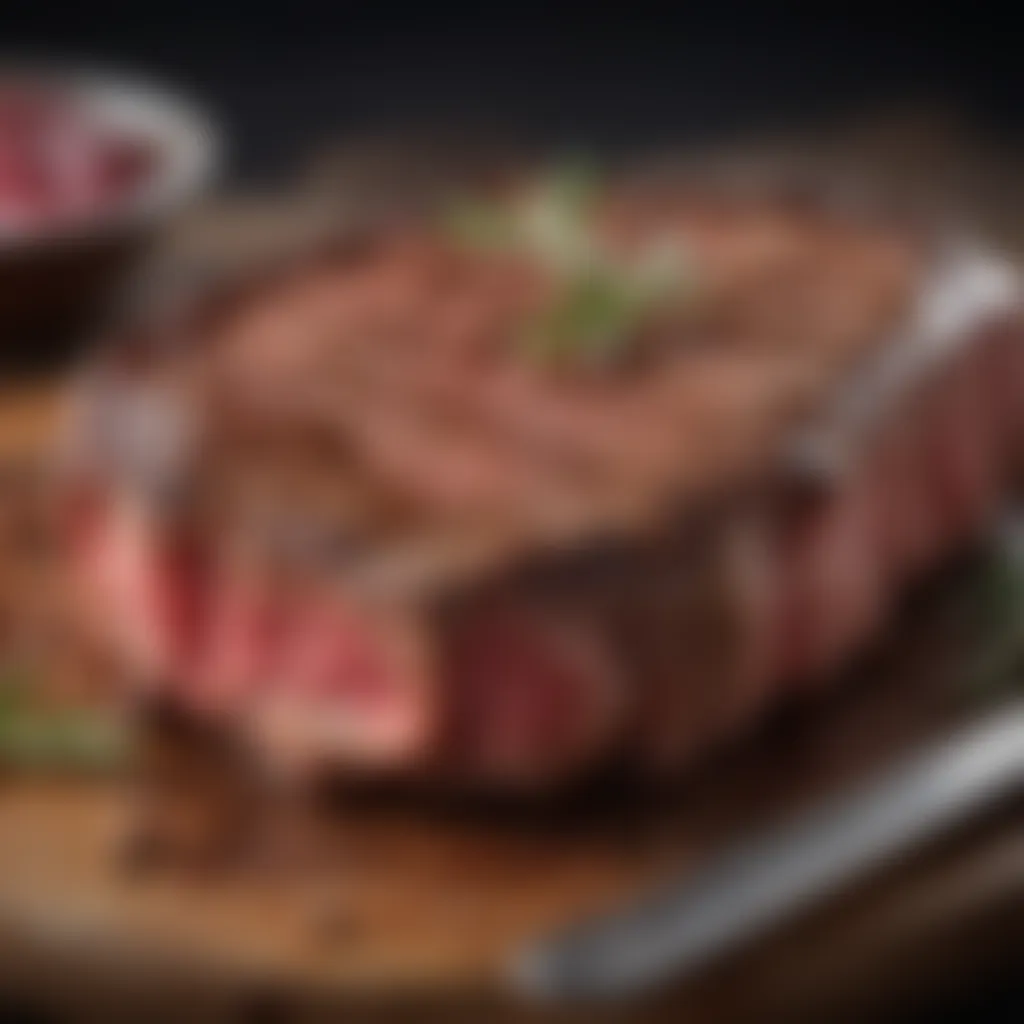
Rare to Well-Done Categories
Doneness categories provide a roadmap for how thoroughly cooked your steak should be. The classic categories—from rare to well-done—serve as a guide but have their nuances.
- Rare: At around 120-130°F, the center is bright red, almost cool. Many chef considers it the purest expression of beef flavor, and it's juicy as can be.
- Medium Rare: 130-135°F, you reach a perfect balance, producing a warm red center. This level is highly regarded for retaining moisture and taste.
- Medium: 135-145°F, you find a rosy center. It's ideal for those who prefer a little firmness but still want plenty of flavor.
- Medium Well: Getting to 145-155°F, the center starts losing its red hue. Some argue flavors diminish here, yet many enjoy the texture at this level.
- Well Done: Over 160°F, there's little to no pink left, often criticized for being dry and tough.
Different steaks and personal tastes will tip the scales. Some folks love that rich, deep flavor of medium rare, while others might crave the simplicity of a well-done cut. Regardless, knowing where each doneness sits within these ranges gives you a significant edge when cooking.
Using a Meat Thermometer Effectively
A meat thermometer is like having a trusted co-pilot in your kitchen. This device can be the difference between a perfectly cooked rump steak and being left with a wrongly prepared piece. The usefulness of this tool is found in its accuracy.
When using a meat thermometer:
- Insert into the thickest part of the steak to ensure you’re getting a true reading of doneness. Don’t let it touch the bone or fat as that can lead to unreliable readings.
- Check often, especially as you near your target temperature. It’s easy to go too far, so catch it at the right moment.
A decent meat thermometer can be a modest investment that pays dividends in flavor and texture, saving you from the uncertainty of touch tests or guesswork.
Visual Cues
Visual indicators can inform the doneness of your steak, even if you don’t have a thermometer handy.
Juice Color Indicators
Juice color is one way to judge doneness visually.
- Rare steak: You’ll see a bright red liquid pooling, indicating that it’s barely cooked.
- Medium steak: The juices will take on a pinkish hue, signaling that it’s achieved a comfortable warmth without drying out.
- Well-done: The juices typically run clear, and this can indicate that the meat is significantly overcooked.
Though some people may lean on visual cues alone, they must be combined with temperature readings for the best results.
Texture Changes During Cooking
Texture is another telltale sign of how cooked your steak is.
- Rare steak: Soft and yielding to the touch, this steak has little resistance.
- Medium steak: Slightly firmer, a gentle squeeze will show springiness.
- Well-done steak: Firm to the core, no yielding at all, indicating it’s reached the upper limits of doneness.
Understanding these changes lets you know when to pull your steak from the oven. It’s a balancing act, yet a rewarding experience when you consistently get it right.
Recognizing the right doneness takes practice but pays off in richer flavors and tenderness, letting you serve a truly standout dish.
Enhancing Flavor
When it comes to cooking rump steak, the flavors can make or break the dish. Enhancing flavor is not just an afterthought; it's the heart and soul of this culinary experience. When you roast, bake, or broil this cut, the right herbs and spices can elevate the taste from ordinary to unforgettable. They work wonders by complementing the beef's natural richness, making every bite savored. This section covers the essentials of enhancing flavor to help you create a mouthwatering rump steak that even your most discerning guests will appreciate.
Using Herbs and Spices
Herb Pairings with Rump Steak
Choosing the right herbs when cooking rump steak is a game-changer. Some popular pairings include rosemary, thyme, and oregano. Each offers a unique character that can bring your dish alive. Rosemary, for example, has a robust flavor that stands up well against the hearty meat. It has a pine-like scent that can take your senses on a delightful journey. Meanwhile, thyme adds a subtle earthiness that harmonizes beautifully with steak, rounding out the flavors without overwhelming them.
One of the best strategies is to create a marinade using these herbs, which allows the flavors to penetrate deep into the meat. However, don't overdo it. The idea is to complement the steak, not to drown its natural flavors. Keep a balance in mind; lighter herbs can get lost and stronger ones can overwhelm. Sometimes, simple is better, and that’s where smart herb choices shine.
Creating Spice Blends
Now, let’s talk about spice blends. Crafting your own can add a personal touch to your cooking. Think of combining black pepper, garlic powder, and smoked paprika for a simple yet effective mix. Black pepper brings heat, garlic powder adds depth, and smoked paprika introduces a hint of sweetness with a little smokiness. This blend can beautifully enhance the hearty taste of rump steak by adding layers of flavor without being too heavy.
A crucial aspect of spice blends is their versatility. You can use them on sides like roasted vegetables or even potatoes, making your meal cohesive and harmonious. Just remember to balance flavors; too much spice can mask the steak's inherent taste. The same applies to salt, which, if not carefully measured, can easily tip the scales from delightful to disastrous. Therefore, experimenting with various ratios will yield the best results.
Finishing Touches
Compound Butters
The realm of finishing touches is where the magic really begins. Compound butters are a luxurious yet simple way to add richness to your steak. They consist of butter mixed with various ingredients like herbs, garlic, or even blue cheese. This creamy topping melts over the hot steak, adding an extra layer of flavor and moisture.
Using a compound butter that incorporates herbs you already used in cooking, like thyme or rosemary, creates a beautiful continuity throughout your dish. Adding a hint of citrus zest can also brighten up the richness of the butter, making it a strikingly balancing choice. This not only enhances flavor but also lends an upscale touch, making even a humble rump steak feel like a restaurant-grade dish.
Finishing Sauces
Finally, don’t overlook finishing sauces. A drizzle of a sauce just before serving can add that pivotal flourish. Think of a simple balsamic reduction; its sweet acidity highlights the savory notes of the steak, creating a balanced forkful. Or, consider a fresh chimichurri sauce, which includes parsley, garlic, vinegar, and olive oil. This sauce not only enhances flavor but also adds a visual punch with its vibrant green hue.
Finishing sauces allow for creativity and can vary based on your mood or the occasion. They can also balance out stronger flavors that may dominate your dish, ensuring that every component shines through. The choice you make here reflects your personal palate and can elevate your rump steak cooking to new heights.
Always aim to enhance balance, keeping the dish from falling flat or overpowering the natural flavors of the meat.
Serving Suggestions
Serving suggestions are essential in elevating the experience of enjoying rump steak. While the cooking process is vital, how you present and pair your dish can make a significant impact. With the right plating techniques and accompaniments, you create not only a meal but an indulgence for the senses. Here’s how you can make your rump steak shine on the table.
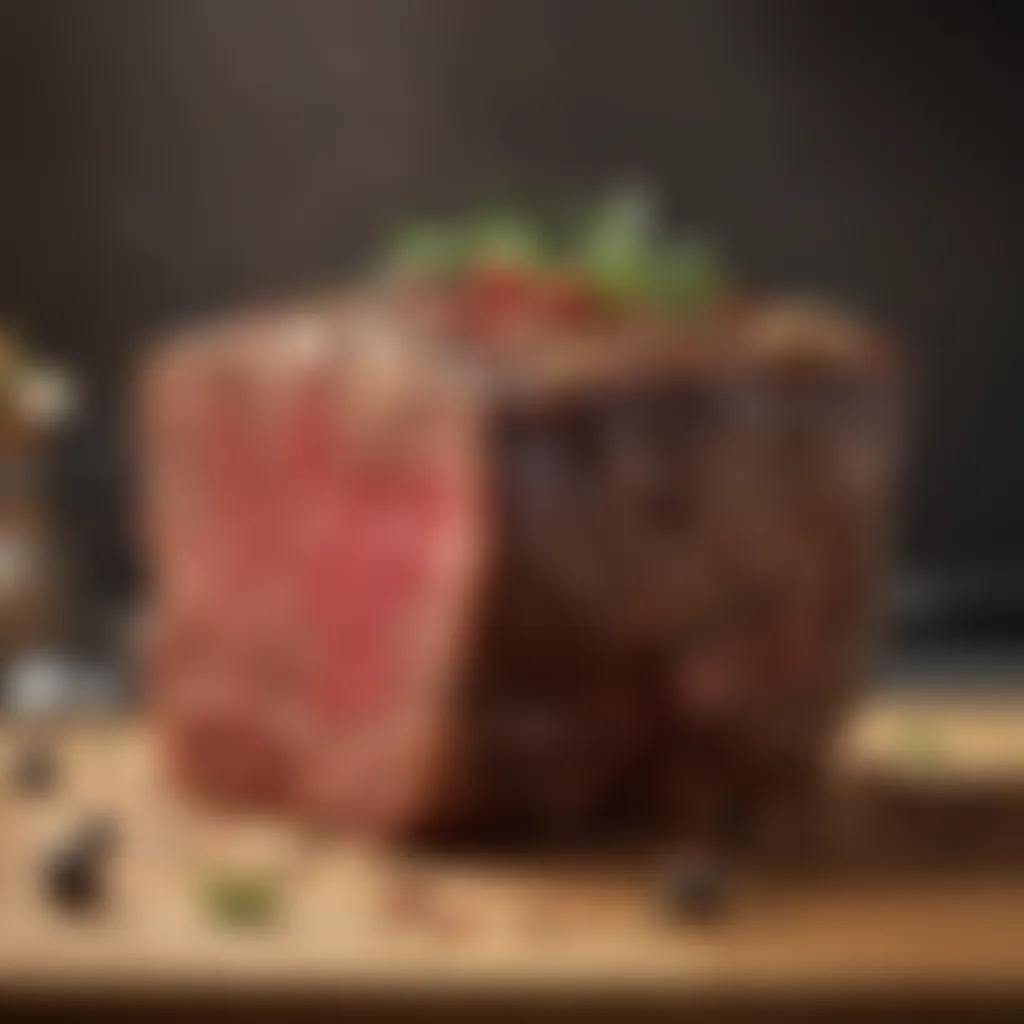
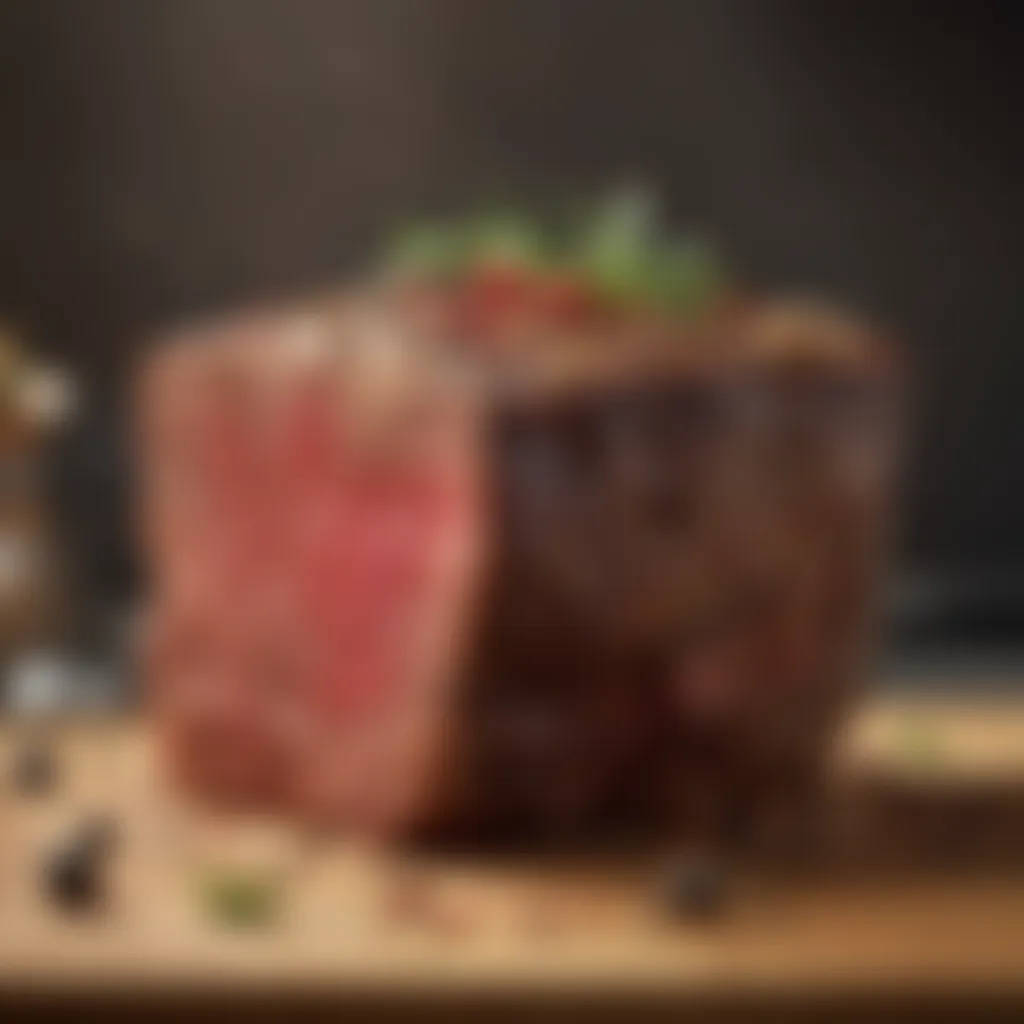
Plating Techniques
Visual Appeal Considerations
When it comes to plating, first impressions count. The visual appeal of a dish plays a crucial role in anticipation and enjoyment. For rump steak, the objective is to highlight its juicy center and seared crust. You might want to consider placing the steak diagonally on the plate, allowing the natural juices to pool slightly. Some might call this the "showcase technique." Garnishing with fresh herbs can add splashes of color and indicate freshness.
Key characteristics to pay attention to include:
- Color Contrast: Pair your steak with vibrant vegetables like grilled asparagus or roasted carrots. They provide not only color but also flavor balance.
- Layering: Layering side dishes like creamy mashed potatoes or a refreshing salad can create depth on the plate. This not only adds esthetic quality but also showcases your culinary skills.
The unique feature of this visual appeal is its ability to draw in your guests. While it may not taste any different, a well-plated dish can enhance the dining experience. The disadvantage, however, lies in the potential for overthinking; simplicity can often yield just as captivating results.
Using Accompaniments
Accompaniments are a critical part of the dining experience. They act as a supporting role to the star dish, providing texture, flavor, and balance. Popular choices for rump steak include sautéed mushrooms or a tangy chimichurri sauce.
The primary advantage of thoughtful accompaniments is that they can highlight the inherent flavors of the steak. For instance, a rich red wine reduction sauce complements the savory essence of rump steak beautifully, making the dish more complex. Potato wedges or a cauliflower puree might lend a comfort-food element that rounds out your meal nicely.
In terms of unique features, the right accompaniments can bring out different notes in the steak. However, one should be cautious; too many sides can overwhelm the main attraction. Aim for a careful selection that enhances rather than distracts from the steak.
Wine Pairing
Eating well is one thing, but pairing that meal with the right wine can elevate your dining experience further. Wine complements flavors and can set the tone for the meal.
Choosing the Right Wine
The choice of wine matters significantly when serving rump steak. A full-bodied red wine, like a Cabernet Sauvignon, offers depth, matching the rich flavors of the steak. This synergy enhances the overall profile of your dish.
Why is this beneficial? Wine’s acidity can cut through the richness of steak, balancing the palate. The unique feature of an excellent wine is its ability to adapt; a good wine serves as an enhancer for both the food and the dining environment.
On the flip side, one should be mindful of personal preference. What complements one person’s steak might not hit the mark for another, so having options is wise.
Understanding Flavor Pairings
Understanding flavor pairings is critical to crafting a harmonious meal. The interplay of steaky richness with the right wine can create a balanced dining experience. For instance, fruity red wines enhance the flavor profiles of grilled or crispy-rubbed steaks.
The key characteristic here is the nuanced balance. A wine that has slight hints of oak or spice can bring out similar notes in the preparation of the steak. More complex wines can introduce an exciting dimension, keeping the meal from feeling one-note.
The unique feature of this knowledge is that it allows for a more personalized touch to each dining experience. However, be careful; some flavor pairings can be too bold or off-putting. Making educated choices here will pay dividends in satisfaction.
Wine and food pairing is an art that, when mastered, can transform an ordinary meal into an extraordinary culinary experience.
Whether during a casual family dinner or a more formal gathering, applying these serving suggestions will elevate your rump steak to its rightful status on the dinner table. Thoughtful plating and well-chosen accompaniments and wine will enrich the overall experience for everyone involved.
Common Mistakes to Avoid
Cooking rump steak, like any culinary endeavor, carries its share of pitfalls. Understanding these common missteps can save home chefs a lot of frustration and disappointment. Whether you're a seasoned cook or new to the kitchen, avoiding mistakes is crucial in achieving a perfectly cooked, tender, and flavorful steak. Here, we will explore two primary errors that can derail your cooking aspirations: overcooking and ignoring resting periods.
Overcooking Dilemmas
Overcooking is arguably the most frequent blunder when preparing rump steak. It’s all too easy to transform a juicy cut into a tough, dry piece of meat by leaving it in the oven just a smidge too long. The challenge lies within the nature of rump steak itself. Being a relatively lean cut, it requires careful monitoring to maintain its tenderness.
To navigate this dilemma, consider using a meat thermometer. Not only does this handy tool allow you to keep a close eye on the internal temperature, but it also invites precision to your cooking. Ideally, cooking rump steak to about 130°F to 135°F will achieve that perfect medium-rare doneness, renowned for its rich flavor and juicy texture.
Some key points to remember:
- Set timers: When cooking, set the timer as a reminder to check on your steak regularly.
- Consider the carryover cooking: Once you remove your steak from the oven, it continues to cook for a few minutes. This could elevate the doneness, so factor that in when measuring your cooking time.
- Be mindful of oven variations: Not all ovens heat the same. Familiarize yourself with your oven's unique tendencies.
"The difference between a good steak and a great one often lies in the cooking temperature."
Ignoring Resting Periods
Another misstep that home cooks often encounter is neglecting the resting period after cooking. When a steak is removed from the oven, the juices inside are agitated and can be pushed to the center of the meat. If you cut into it right away, those precious juices may cascade out, leading to a dry dining experience.
Allowing the rump steak to rest for about 5 to 10 minutes after cooking is paramount. This brief interlude not only lets the juices redistribute throughout the meat but also enhances the overall flavor. During this time, the muscle fibers relax, resulting in a tender bite that everyone craves. Here are practical tips for resting your meat:
- Cover loosely with foil: Lightly tent your steak with aluminum foil to retain warmth while still allowing it to breathe.
- Use the time wisely: While your steak is resting, take the opportunity to whip up a sauce or finish off any side dishes.
- Do not rush: Patience pays off. Waiting those few extra minutes can make all the difference in texture and moisture.
The End
In this article, we've traversed the intricacies of cooking rump steak in the oven, underscoring its importance in the culinary world. Rump steak is not just any cut of meat; it has robust flavors and a texture that makes it a favorite for many. Mastering these techniques is essential not just for achieving a properly cooked steak, but also for boosting your confidence in the kitchen. After all, cooking is as much about skill as it is about understanding and adapting to the ingredients you’re using.
Recap of Key Techniques
As we wrap up, let’s revisit some of the core techniques discussed:
- Choosing Quality Meat: The foundation of any good steak lies in selecting a cut that meets your expectations for flavor and tenderness. Rump steak with good marbling will be a game-changer.
- Cooking Methods: Each method—roasting, baking, and broiling—has its own merits. Roast for a slow, even cook, bake for gentle heat, and broil to achieve that perfect sear.
- Using a Meat Thermometer: Nothing beats the precision of a meat thermometer in checking the doneness of your steak. It takes the guesswork out of the equation.
Utilize these insights as stepping stones on your journey to mastering rump steak perfection.
Encouragement for Culinary Experimentation
Finally, don’t shy away from experimenting! The best dishes often come from a pinch of creativity and a dash of courage. Think about incorporating different herbs, spices, or marinades into your cooking routine. For instance, a marinade infused with rosemary and garlic can do wonders for your steak’s flavor profile.
Trying new techniques is equally beneficial. Perhaps give a reverse sear method a go, or pair the steak with unconventional sauces like chimichurri or mushroom cream. The beauty of cooking lies in its adaptability, so feel free to challenge norms and let your palate guide you. Remember, the kitchen is your canvas—make it a masterpiece with each dish you create!







